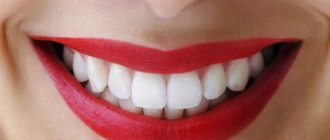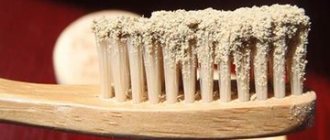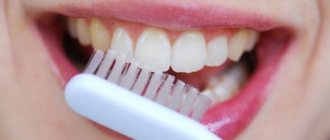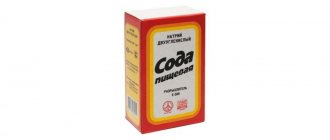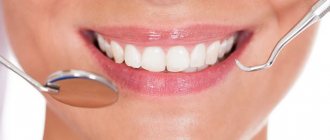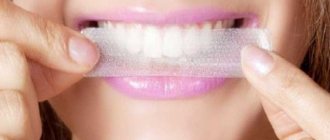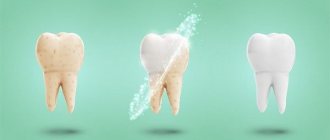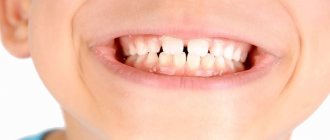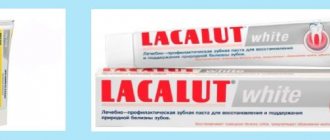Types of teeth whitening in dentistry
Professional teeth whitening involves performing procedures in a dental office and under the direct supervision of a specialist. In this case, mechanical or chemical effects may be exerted on the tooth enamel. The effectiveness of the latter can be enhanced by the penetrating ability of ultrasound, laser or light, which act as an activator and conductor for the reagent that penetrates deep into the enamel.
Today there are a number of popular whitening methods, each of which has its own advantages and disadvantages. Their descriptions will help you give preference to one or another procedure.
Professional oral hygiene as an alternative to whitening
You have learned about teeth whitening and its types, but before you decide on one of the previously listed methods, pay attention to the complex of professional oral hygiene. It is carried out in a clinical setting, and always in preparation for the enamel lightening procedure. Why do experienced doctors advise starting with professional hygiene? Let's list:
- the procedure helps to remove all types of plaque, level the surface of the enamel, accordingly, then bleaching compounds act on it much more effectively, and the patient receives the best possible result and a uniform shade,
- after brushing, the teeth become 1-2 shades lighter, the enamel is smooth, shiny and well-groomed, which is more than enough for many patients not to resort to other whitening techniques,
- The method is suitable for those who prefer naturalness to Hollywood and not always natural whiteness. At the same time, it has a gentle effect on the enamel, and upon completion of the procedure, hard tissues are also strengthened with fluoride,
- the complex is ideal for people for whom other whitening methods may be contraindicated. For example, patients with fluorosis, hypoplasia, wedge-shaped defect, erosion, thin and sensitive enamel, pregnant and lactating women, children.
Professional oral hygiene will help to lighten your teeth.
Professional hygiene is carried out using ultrasound, Air-Flow water-abrasive cleaning, various polishing brushes and pastes. Each manipulation can be performed separately, but for greater efficiency they are often performed in combination.
Notice
: Undefined variable: post_id in
/home/c/ch75405/public_html/wp-content/themes/UltraSmile/single-item.php
on line
45 Notice
: Undefined variable: full in
/home/c/ch75405/public_html/wp-content /themes/UltraSmile/single-item.php
on line
46
Rate this article:
( 2 ratings, average: 5.00 out of 5)
whitening
- Proskuryakova A.S. Types, advantages and disadvantages // Bulletin of medical Internet conferences. – 2015.
- According to the official website magic-white.ru
- Novak N.V., Baytus N.A. Correction of optical properties of pulpless teeth // Bulletin of Vitebsk State Medical University. – 2022.
Expert “It is important to understand that all types of teeth whitening can pose a potential threat to oral health if proper professional training has not been carried out before the procedures (plaque removal, treatment of pathologies) and the list of contraindications is not taken into account: multiple caries, thin and sensitive enamel, inflamed gums, severe fluorosis and other non-carious defects, pregnancy and lactation in women, age up to 18 years.” Dentist-therapist Tatyana Vitalievna Varlamova
Consulting specialist
Orlova Elena Vladimirovna
Doctor rating: 9.5 out of 10 (2) Specialization: Dentist-therapist Experience: 33 years
Photobleaching
One of the “youngest” whitening methods. During its use, a special whitening gel is applied to the visible surface of the teeth, with a minimum concentration of hydrogen peroxide, which, under the direct influence of light emitted by a halogen lamp, is activated and penetrates deep into the enamel, while breaking down its pigment plaque. This procedure is often called ZOOM whitening, since the ZOOM-4 series device can be used for it. You can sign up for a whitening procedure using the ZOOM-4 device on our website
Advantages
- Quick visible effect.
- Suitable for patients with sensitive tooth enamel.
- If you follow the dentist's recommendations, the effect lasts up to 2 years.
Flaws
- The duration of the procedure is 1.5 – 2 hours in the dentist’s chair.
- Unpleasant taste in the mouth after the procedure.
- There may be an effect of “unnatural whiteness” of teeth, with a blue tint.
What is photobleaching
Photobleaching is a modern way to make enamel lighter using a special gel, the particles of which become active when exposed to special lighting. At home, this method is not used, since it requires certain equipment in the form of a brightening lamp. The ability to whiten enamel by several tones (10-12) depends on the choice of gel.
Pros and cons of this method
Since the procedure may be contraindicated for a number of reasons, the dentist will decide whether to perform it. If there are no contraindications, then photo whitening will not only help lighten your teeth, but also strengthen them. The main advantages of the method include:
- No risk of enamel damage.
- Visible results immediately after the procedure.
- A small number of contraindications to the procedure.
- Almost complete absence of side effects.
- The duration of the procedure is short (a photo-bleaching session lasts on average from 20 to 40 minutes).
The disadvantages of the method include, first of all, the price of photobleaching, so not every person can afford this procedure. In addition, there are a number of diseases for which this method cannot be applied. Therefore, you should definitely tell your dentist about all your illnesses. Here are a number of pathological conditions and other reasons for which you will be refused the photobleaching procedure:
- There is an age barrier, so this method is not suitable for people under 20 years old.
- Allergy to the active components of the gel composition.
- Diseases of the dentition in which the enamel is quickly worn away.
- Presence of leaky seals.
- Pregnancy and breastfeeding.
Photobleaching system
Photobleaching can be carried out in several ways:
- Beyond Polus lamps. Cold light and two radiations are used - halogen and LED.
- Luma Cool. LED lamps emit a cool stream of light. The whitening effect lasts up to several years.
- Zoom. Ultraviolet lamps heat the enamel. This method is dangerous due to its destruction, but the effect lasts for years.
- Luma-Arch. Halogen light is used, a gentle method, only problem areas are lightened.
Air Flow
This is a mechanical cleaning of enamel that effectively removes plaque and hard deposits (tartar) from the surface of teeth. To carry it out, Air flow sandblasting equipment is used, which supplies the enamel surface with a high-pressure stream consisting of water, an abrasive substance and air. Common soda crystals are used as an abrasive, destroying dental plaque and polishing enamel. Learn more about Air Flow teeth brushing.
Advantages
- During the procedure, tartar is removed, a common cause of caries.
- Ability to clean hard-to-reach places.
Flaws
- Lightening by only 2 - 3 tones.
- During the procedure, patients with sensitive enamel experience pain.
Comments
Which professional method can still be considered the best?
Bogdan (10/11/2020 at 11:14 pm) Reply to comment
- It all depends on the clinical situation, the patient’s expectations and his financial capabilities.
Editorial staff of the portal UltraSmile.ru (10/14/2020 at 09:25) Reply to comment
I just have very sensitive teeth. I had it cleaned at the clinic, but it didn’t really help change the shade. I want more whitening effect...
Arina (10.30.2020 at 15:45) Reply to comment
- Dear Arina, perhaps you better consider microprosthetics, when the enamel of the teeth is covered with thin overlays made of ceramic, composite or zirconium dioxide. Such overlays can be snow-white at the request of the patient. They will not only give your teeth the desired level of whiteness, but will also hide minor defects (cracks and chips, old fillings, crevices). They will also protect sensitive enamel from external factors, prevent its destruction, and help reduce the level of discomfort from hard, cold, hot and sour foods.
Editorial staff of the portal UltraSmile.ru (03.11.2020 at 09:17) Reply to comment
Write your comment Cancel reply
Chemical bleaching
The name of the method speaks for itself and involves applying a special chemical based on hydrogen peroxide to the visible surface of the teeth. Penetrating deep into the enamel, it destroys pigment molecules, and teeth become 4 to 10 shades lighter.
Advantages
- Quickly achieve the desired effect.
- A long-term result, which, if the recommendations are followed, can last for 1.5 years.
Flaws
- Tooth enamel becomes more sensitive.
- If the gums are poorly insulated during the procedure, they can get burned.
Second group: home methods
Home methods fall into several categories.
Whitening with professional products
The procedure is carried out at home. For example, using gels developed by manufacturers of well-known office techniques (Zoom, Amazing White, Opalescence). For better effect, they are used in conjunction with mouth guards.
The group of professional products also includes various toothpastes with hydrogen peroxide and a high content of abrasive particles, strips and pencils. The products are represented by popular and not so popular brands: Splat, ROCS, Rembrandt, PresiDENT, Crest, Amazing White.
For whitening, the tray is filled with a special whitening composition
What are the advantages of such funds:
- they are considered relatively safe, since they were created at production sites under the guidance of experienced specialists, have a proven composition, and also contain useful minerals and enamel-strengthening components,
- can be used at home,
- These whitening products are presented in a wide range and in all price categories.
What effect do professional products for home use promise? If we are talking about gels with hydrogen peroxide from well-known manufacturers of office techniques, then with the right approach they can lighten the enamel by up to 4-6 tones. When buying strips and pencils, the result will be more modest - 3-4 tones. If you use whitening pastes, then the most you can count on is 1-2 tones.
It is assumed that the selection of a professional home whitening product should be carried out by a doctor who has previously examined the patient’s oral cavity and prepared for the procedure (treatment of teeth and gums, removal of plaque, strengthening of enamel). The specialist explains how to use this or that composition, after which the patient performs all the prescribed manipulations at home, but strictly in accordance with the instructions and recommendations given.
However, it often happens that a person buys professional products without consulting a dentist at all and without preparation, which is no longer safe and does not promise the effect guaranteed by the manufacturer.
Whitening strips are also used for these purposes.
The disadvantages of these types of whitening include that it will not be possible to achieve an instant result - you will have to use the products for at least 10-14 days. And the effect will last for only 1-3 months, maximum – for 1-2 years, if you use professional gels with mouth guards, and only if all restrictions are observed (“white” diet, smoking cessation, daily thorough oral hygiene).
Home whitening using non-professional products
This group includes types of teeth whitening, where it is assumed that enamel lightening can be achieved through the use of natural products and folk recipes. They are inferior to professional (office and home) methods in efficiency and safety. They need to be used for a long time in order to ultimately lighten the enamel by just 1 shade.
Of course, dentists do not recommend using traditional recipes, as they can do more harm than good. However, they cannot be ignored in the section of our article, because many people, one way or another, try to improve the color of enamel with the help of various natural ingredients: hydrogen peroxide, activated carbon, strawberries, lemon juice and peel, turmeric, banana peel, tea oil tree and so on.
Banana peel can be used in home teeth whitening
Ultrasonic whitening
The use of ultrasound in combination with special pastes and gels based on oxidizing agents, which are pre-applied to the visible surface of the teeth, gives a fairly good result and will lighten the enamel by 2 - 3 tones.
Advantages
- The method is suitable for patients with sensitive tooth enamel.
- No pain.
Flaws
- To achieve maximum effect, several procedures will be required.
Whitening with a discount of 5000 rubles!
Moscow
ZOOM whitening method
The Zoom teeth whitening system has been around for a long time. There are three types: Zoom, Zoom 2 and Zoom 3. Today, the most popular, safe teeth whitening method is Zoom 3. The main advantage of this technology is a snow-white smile that will last for a long time. Gentle teeth whitening is another feature of the method. The effect of the gel on the tooth is gentle and safe. The procedure can be performed even if there are diseases of the oral cavity. Lightening of tooth enamel occurs evenly. Another advantage is that after the procedure the enamel is strengthened and a preventive effect against caries occurs. During the procedure using the Zoom 3 method, no pain is felt due to the local influence of the device’s beam. In one procedure, you can lighten tooth enamel by 10-12 shades.
Endobleaching
Endodontic lightening of tooth enamel (or as it is often called intracanal whitening) is a labor-intensive procedure that allows you to lighten pulpless teeth and teeth with cracks on the enamel surface. The problem is that, being damaged, they darken from the inside over time and a superficial effect on the enamel in this case does not have a positive effect. Therefore, to lighten them, a special whitening gel is introduced into the tooth cavity, followed by a filling.
Advantages
- The method allows you to lighten damaged teeth and enamel.
- Painless procedure.
- It is possible to lighten the enamel by 8 – 10 tones.
- You can lighten only one or two affected teeth.
Flaws
- Tooth tissues become more fragile.
- To achieve maximum effect, 2–4 procedures will be required.
Causes and consequences of darkening of tooth enamel
Discoloration is a fairly common phenomenon. Its detection is a direct signal notifying that you are in danger. As a rule, the cause of plaque and darkening is:
- Failure to comply with hygiene rules, resulting in the accumulation and compaction of plaque from food debris and bacteria;
- Smoking. The resinous substances contained in the smoke first change the tone, and later completely turn the smoker’s teeth dark brown;
- Abuse of wines and bright juices, herbal tinctures, black tea, coffee. Natural and synthetic food dyes eat into enamel quite easily;
- Sweets. The consequence of excessive consumption of sweets can be a carious process that changes the optical density and color of the affected tooth;
- Excess fluoride. Drinking drinking water with a high content of this chemical element can cause not only aesthetic discomfort, but also endemic fluorosis - a rather serious disease;
- Poor quality treatment. Some substances included in outdated filling materials significantly change color after procedures;
- Injury. Damage to the neurovascular bundle instantly changes the shade, and the consequence of tissue breakdown will inevitably be complete darkening;
- Antibiotics and medications. Taking certain medications by pregnant women contributes to the accumulation of harmful substances in the developing buds of the fetal teeth, which threatens the unborn child with an unpleasant enamel color;
- Diseases and hereditary diseases. Unfortunately, in such cases, teeth whitening is not effective; therapeutic or orthopedic treatment will be required;
- Age-related changes. Aging of fabrics changes not only the shape and structure, but also the color.
It is necessary to realize that darkening of the enamel, regardless of the cause, will inevitably lead to more serious problems. Pathogenic bacteria thrive in plaque, where a favorable environment is created for the destruction of diseases that contribute to destruction. Often, darkening is followed by caries and the loss of one or more teeth.
Laser whitening
One of the most popular methods of enamel lightening. During his procedures, a whitening gel is applied to the surface of the teeth and exposed to a laser, which activates the formula.
Advantages
- Quick visible effect.
- Lightening of enamel by 6 – 10 tones.
- Bactericidal properties of the procedure.
- If you follow the dentist’s recommendations, the effect lasts for 1.5 – 2 years.
Flaws
- During the first day after the procedure, the sensitivity of tooth enamel increases.
Absolutely all professional teeth whitening procedures have contraindications. Therefore, before carrying out them, you need to consult with your attending physician and dentist.
How to care for your teeth after whitening
After you make your smile snow-white, you will need to observe oral hygiene more carefully, of course, if you want the result to last for a long time.
During the first 48 hours, you must avoid foods that stain the enamel. Eliminate the following foods:
- Chocolate;
- Coffee;
- Tea;
- Juices, fruit drinks, red wine;
- Lemonades and sodas;
- Confectionery products containing dyes;
- Beets and carrots;
- Adjika, ketchup, soy sauce, etc.
In addition, it is very advisable to refrain from smoking for two days. As a last resort, use an electronic cigarette. Next, for two weeks you need to reduce the number of cigarettes you smoke as much as possible.
Daily hygiene plays an important role in maintaining white teeth. Brush your teeth at least twice a day, and preferably after every major meal. Be sure to use dental floss to prevent food debris from accumulating in areas that are difficult to reach with a brush. The use of rinses is also recommended; this will more effectively combat the growth of harmful bacteria, soothe the gums and help maintain whiteness.
For cleaning, it is best to use whitening and remineralizing pastes.
For example, the professional toothpaste “ASEPTA PLUS” Gentle Whitening is designed for effective and safe teeth whitening without restrictions on the period of use.
The product guarantees enamel lightening by 1.5 tones within 4 weeks of use, as well as a significant (3.4 times) increase in anti-caries effectiveness.
Whitening Pencil
The active ingredient in whitening pencils is still hydrogen peroxide. To lighten the enamel, a light gel is applied to the visible surface of the teeth using a special pencil applicator and left for the time specified in the instructions, after which the mouth must be rinsed thoroughly.
Methods for teeth whitening:
- For those whose teeth naturally have a beautiful white color, mechanical (abrasive) whitening is suitable. This method will help restore the natural whiteness of the enamel. The principle of operation is as follows: a special nozzle is put on the teeth and cleaning occurs under pressure with a mixture of powder, water and compressed air. In this way you can remove plaque, deposits, pigments from tea, coffee and nicotine. This is a safe teeth whitening as there is no strong impact on the teeth.
- The ultrasonic method is a virtually harmless teeth whitening. In addition to the above disadvantages, this method can cope with tartar. Finally, the teeth are treated with a special polishing paste, which will protect the teeth from coloring pigments for a long time. There is a technology that includes exposure to water and ultrasound. An ultrasonic scaler is used. This method will help clean the enamel from the most dense and long-term deposits. The cost of teeth whitening using this method is not cheap, but the results are worth it. This is a quick teeth whitening.
- The most common method is chemical bleaching. The active ingredients used are the same as in the home procedure, only their concentration is higher. To achieve a good result, several half-hour sessions will be required. Teeth whitening in dentistry using this method has a fairly deep and strong effect. The procedure can be performed in the dentist's office or at home, but under the supervision of a doctor. The results of the procedure will please you for up to 5 years. Then you can repeat the whitening. The procedure should not be performed if there are fillings, pins, or dentures on the visible surfaces of the teeth. This is due to the fact that such materials react differently to abrasive substances, and an ideal result cannot be achieved. For such cases, a laser whitening system has been developed. The price of chemical whitening will depend on the materials used during the procedure.
- Laser whitening method. This method is less gentle, but more effective. The laser penetrates deeper into the tooth tissue. The procedure can be carried out pointwise, that is, the dentist adjusts the laser power depending on the condition of the tooth. This effective teeth whitening lasts up to seven years. The cost of laser teeth whitening varies from clinic to clinic and will depend on the pricing policy of the dentist. Inexpensive teeth whitening in Moscow is carried out by private offices, which, unlike online giants, value their clients and are always ready to accommodate them.
- Photobleaching. The main advantage of this method is the ability to whiten sensitive teeth with microcracks, chips, and loose fillings. The principle of operation is as follows: a special composition is applied to the tooth, from which, under the influence of halogen light, oxygen is released and removes dark spots. The only downside is that the result is a too dazzling white color, which does not suit everyone. If you take proper care of your teeth, the effect of photowhitening can last a lifetime. This is a safe, harmless teeth whitening.
Sometimes, scrolling through advertising brochures of dental clinics, you can come across an offer for conservative and transformative whitening. The first method is the same as returning your teeth to their natural color. The second method is more aggressive - a soft abrasive agent is applied to part or the entire tooth.
Whitening strips
The principle of operation of the strips is very similar to the mechanism of a pencil. These are special soluble or insoluble strips that are fixed on the visible surface of the teeth in the smile area and left for the recommended time, during which the active substance based on hydrogen peroxide penetrates the top layer of tooth enamel and brightens it.
Special toothpastes
This is the most affordable way to whiten teeth at home. As a rule, these pastes contain abrasive particles that remove plaque and polish the enamel, making it lighter.
The main advantage of all home whitening methods is that they are affordable. But with their help, it will be possible to lighten the enamel by no more than 2–3 tones, and to maintain this effect, the procedures will have to be repeated with enviable regularity.
Important to remember!
Uncontrolled use of home teeth whitening methods can damage the enamel and cause its thinning. In addition, all of them, like professional methods, have their contraindications and require prior consultation with a dentist.
Using Zoom technology for whitening is strictly contraindicated if:
- The presence of a large number of fillings, caries;
- Gum disease;
- Allergies to used drugs;
- A tumor of a malignant nature;
- undergoing chemotherapy;
- Pregnancy and breastfeeding;
- Age less than eighteen years.
Teeth whitening in Moscow using the Zoom method is cheaper than laser.
When choosing a method, it is better to consult with professionals and contact a clinic that is licensed for this procedure and has experienced dental hygienists on its staff.
There are many small clinics in Moscow that offer affordable teeth whitening. Cheap doesn't mean bad. Sometimes a visit to inexpensive dentistry leaves a better impression, and the result of the work surpasses expensive treatment.
In the end, I would like to say that taking care of your teeth should come first. Problems with the oral cavity can cause gastrointestinal diseases and other health problems. We wish that teeth whitening for residents of the city of Moscow takes place quickly and pleases with its results.
Is teeth whitening harmful?
The peculiarity of all whitening methods is their relative safety. On the one hand, if the patient has absolutely healthy, strong teeth, then the enamel lightening procedure, carried out once every 2-3 years, will not cause much harm. On the other hand, regular use of chemical reagents that whiten teeth causes a gradual thinning of tooth enamel and makes it sensitive. Home lightening is especially dangerous when patients use available and advertised whitening products without taking into account their specificity and the individual characteristics of their enamel.
Before you sign up for a whitening procedure, you must consult a dentist and choose a real professional to perform it. A correctly calculated concentration of the active substance applied to the enamel, the depth and time of its exposure will minimize the risk of complications after bleaching and its negative impact on the enamel.
Methods for whitening at home
Those who want to get themselves in order without leaving home can also easily find a decent option for themselves. The main thing is accuracy and moderation. And we discussed this issue in more detail in the material “Home teeth whitening - TOP 10 methods.”
Whitening toothpastes
Such products really help get rid of the notorious plaque and lighten the tones somewhat. However, their use is fraught with the appearance of micro-scratches. To achieve a noticeable effect, you will need to regularly use a suitable preparation, the continuous use of which increases the risk of damaging the enamel. You can buy cross brand toothpaste from the USA in this section.
Table soda
An effective, safer, but still merciless way to whiten your teeth at home. In this case, the color will not change, but the soda used as an abrasive will certainly clean the teeth that have been rubbed with it from plaque and will certainly damage the protective shell.
Hydrogen peroxide
Depending on the concentrate of the substance and the duration of its use, it can make the smile snow-white: the longer the product is not washed off, the whiter the teeth become. One main fact that should not be overlooked is that frequent use of hydrogen peroxide as a whitening agent can cause gingivitis or periodontitis. Therefore, in order to avoid damage to the gums and increased sensitivity, you should not abuse the drug.
Wood ash
Potassium hydroxide contained in the ash has bleaching properties. After applying, leaving for some time and rubbing the teeth with the substance, the result will be visible, but the effect will be extremely short-lived. And frequent use of the method, in turn, has an extremely negative effect on the enamel.
Mouthguards
One of the safest and most effective methods requires third-party intervention from a specialist - you will need to make an individual mouthguard based on dental impressions. To whiten using this method, you will need a special gel and a tray itself. It is enough to apply the gel, put on the nylon product, wait and your smile will shine white.
Whitening strips
A new product that has caused a real sensation in the field of dentistry. Having gathered together the accumulated knowledge and best practices, the world-famous leader in the production of hygiene products has found the optimal solution to the pressing problem. Created by true professionals, the Crest 3D White Whitestrips system for home teeth whitening has created a method that satisfies all needs. Elastic strips that follow the shape of your teeth when “glued” are already covered with an optimal amount of gel that is safe for enamel and gums. All you have to do is stick the strip on, wait and get real 3D whitening that makes your smile truly brilliant and natural.
In addition, today Crest 3D White Whitestrips is perhaps the only product that does not harm the enamel, even when using several strips one after another. The effect is guaranteed to last for at least 12 months, which is simply impossible when using other methods of teeth whitening at home.
